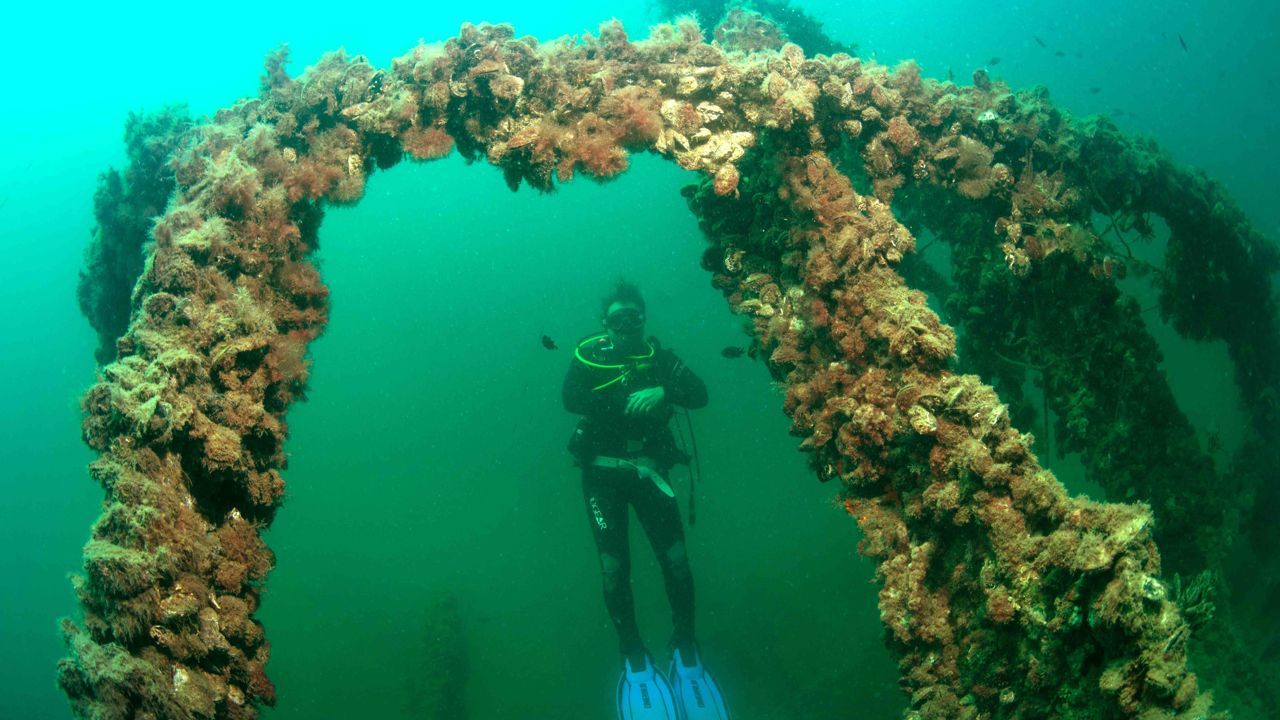War wrecks draw diving enthusiasts to Gelibolu Underwater Park
The Gelibolu Historical Underwater Park has emerged as a prime destination for diving enthusiasts, featuring wrecks that bear significant traces of war

World War I shipwrecks were introduced as a new attraction for diving tourism in 2021 with the initiatives of the Ministry of Culture and Tourism initiatives, Gallipoli Wars, and Gallipoli Historical Area Presidency. These historic sites have become one of the favorite routes for underwater history enthusiasts.
The Gallipoli Peninsula now attracts tourists not just for its historical landmarks, such as the martyrs' cemeteries and monuments, but also for its underwater shipwrecks, which bear traces of a conflict that took place 109 years ago.
Divers can explore underwater remnants of history at 14 different points, including the HMS Majestic, HMS Louis and other wrecks like Ertugrul Bay Massena, Saghalien, Helles Barges, Tekke Bay (W Beach), Ariburnu Barges, Kucukkemikli Barrels, Ariburnu Layter, Lundy, S.S. Milo, Tuzla, the Submarine Obstacle Network, Baby Rocks, and HMS Triumph.
First shipwreck of Gallipoli War
The Battleship Mesudiye, which went down in history as the first shipwreck of the Gallipoli Wars, was ordered to the British company Thames Iron Work Company in 1872, together with the Battleship Memduhiye, as a result of Sultan Abdülaziz's (1861-1876) policy to modernize the Ottoman Navy.
The battleship was built in 1873 and launched in 1875. On the morning of Dec. 13, 1914, the British submarine HMS B11, under the command of Lt. Norman Douglas Holbrook, torpedoed the Battleship Mesudiye after passing through minefields.
Of the 598 people on the sinking ship, 10 officers and 25 privates were martyred. Many of the weapons on board the vessel were salvaged and used to strengthen the defenses of the Dardanelles.
This battery, named Mesudiye Bastion in honor of the ship, helped sink the French battleship Bouvet in March 1915.
HMS Lundy remained in one piece
The 188-ton trawler HMS Lundy, built in 1908, one of the rare shipwrecks left in one piece in the depths of Canakkale, was seized by the British during World War I and sent to war.
The British sunk HMS Lundy, which served as Britain's minesweeper during the war, on Aug. 16, 1915, when they realized they could not pass the Dardanelles.
The HMS Lundy shipwreck, situated at a depth of 27 meters (88.58 feet) in Suvla Bay between Buyuk Kemikli and Kucuk Kemikli, offers a vibrant underwater experience with colorful sponges, groupers, sea turtles, weasels, bream, lobsters, insects, sea hares, and moray eels visible in the area.
Second submarine to infiltrate Marmara Sea
The British submarine HMS E 14 is known as the second submarine to infiltrate the Marmara Sea after B11 during the Gallipoli Wars.
The submarine HMS E 14, which was hit by Turkish coastal artillery in Kumkale and has been a silent witness of history in the depths of the Bosporus for 109 years, went to Canakkale to attack the Ottoman Navy ship Yavuz, which ran aground in Nara Cape on Jan. 28, 1918. It entered through the Strait.
Meanwhile, the HMS E 14 submarine, which was caught in the nets at Cape Nara, was forced to surface with underwater bombs. As the captain of the submarine attempted to retreat and flee toward the Aegean Sea, the ship was sunk by cannon fire near Kumkale, killing 27. Only five people managed to survive the attack.
The wreckage of the submarine HMS E 14 could not be found for a long time.
Türkiye's most famous shipwreck
HMS Majestic joined the Combined Navy, established for the Battle of Gallipoli at the beginning of World War I.
The 128-meter-long battleship was torpedoed and sunk by the German submarine U-21 under the command of Otto Hersing on May 27, 1915, while hitting the Turkish troops in Seddulbahir with cannon fire.
Türkiye's most famous shipwreck, located at a depth of 18-23 meters off the coast of Seddülbahir, was off-limits for diving for many years. However, with the initiatives of the Gallipoli Historical Site Directorate of the Gallipoli Wars, diving access has been granted to the public.
HMS Louis Frigate diving point
Although attempts were made to save the destroyer-type HMS Louis Frigate, which was damaged after colliding with a tugboat during the Gallipoli War and dragging and settling on the sand, they were unsuccessful.
The wreck, located 14 meters on Buyuk Kemikli Cape, has become an essential underwater diving point where the diversity of fish and living things can be photographed perfectly.
Locomotive of diving tourism in Türkiye
Canakkale Wars Gallipoli Historical Area President Ismail Kasdemir told the AA correspondent that the Historical Area Presidency has created an underwater park due to exceptional work spanning 150 square kilometers in Canakkale.
Source: AA









